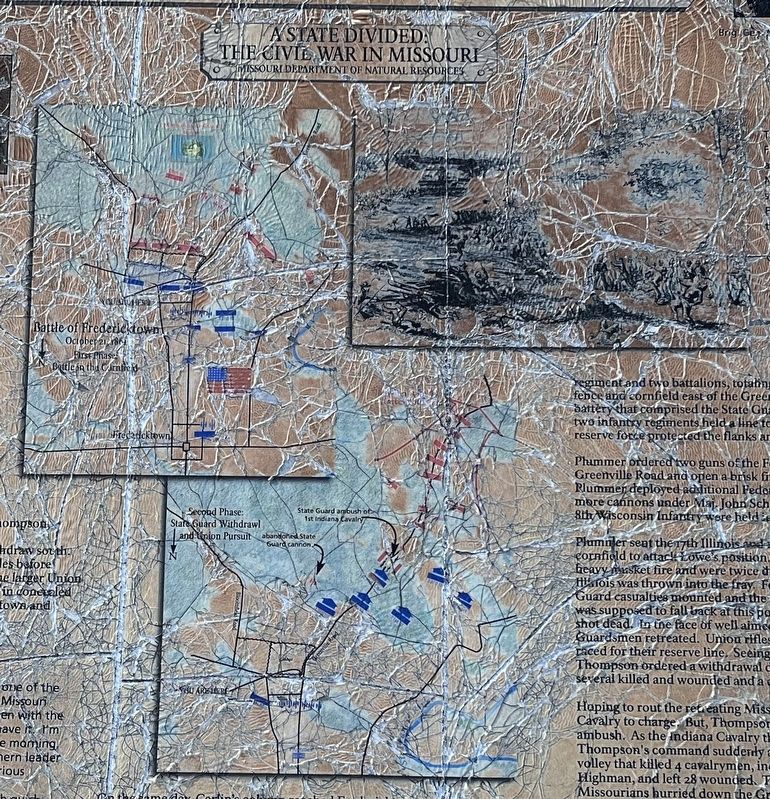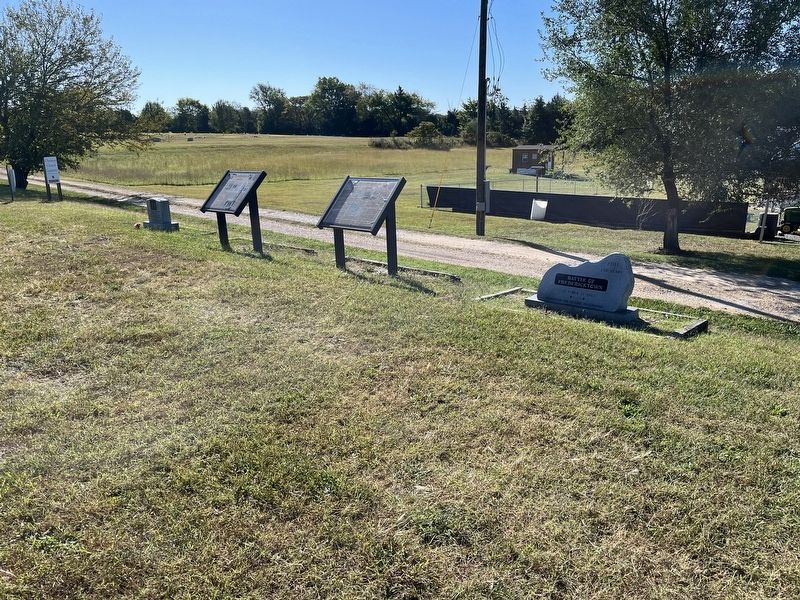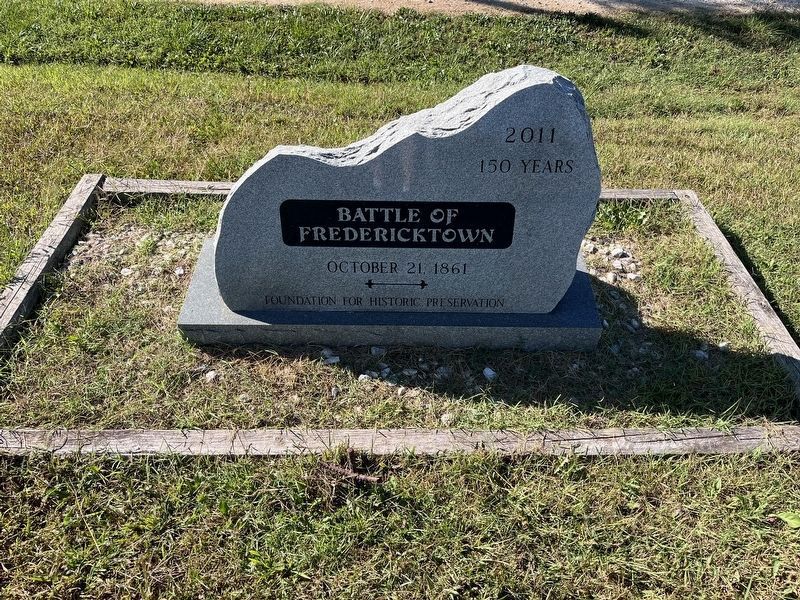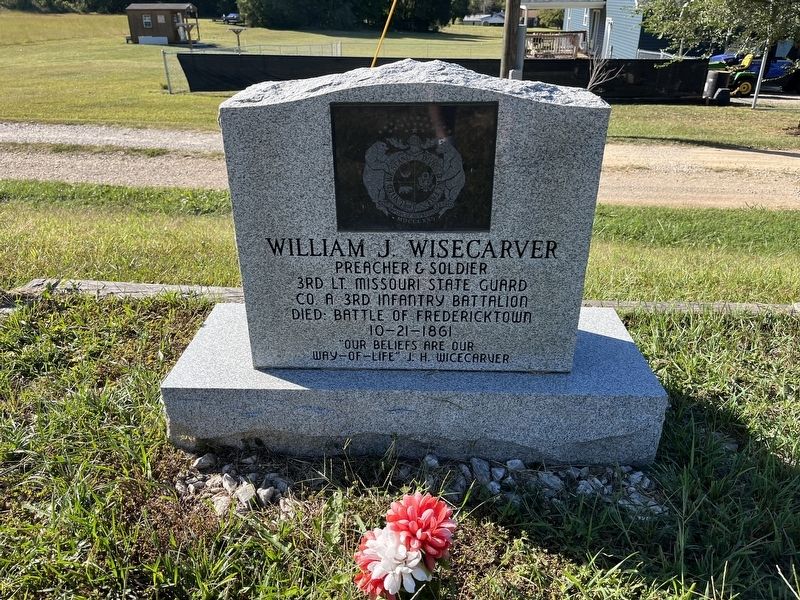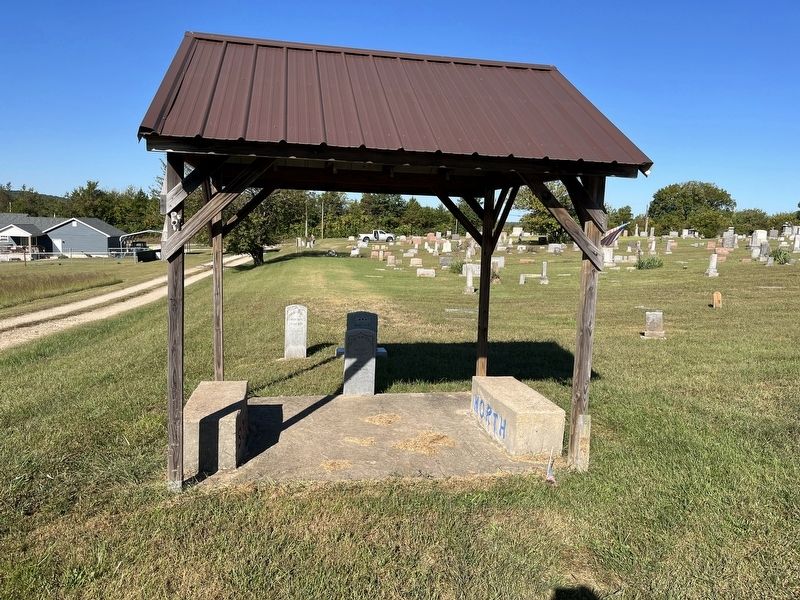Fredericktown in Madison County, Missouri — The American Midwest (Upper Plains)
Battle of Fredericktown
A State Divided:
— The Civil War in Missouri —
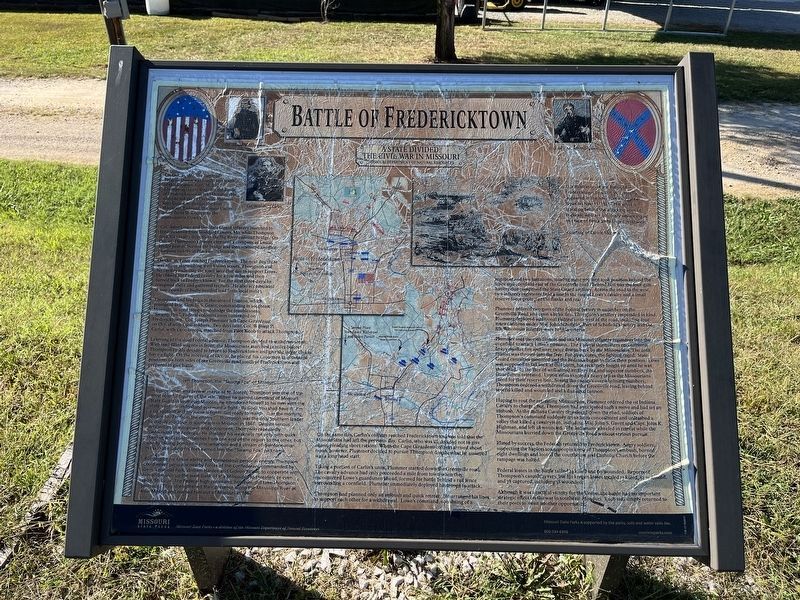
Photographed By Craig Swain, September 27, 2022
1. Battle of Fredericktown Marker
The marker is in a greatly deteriorated state due to weathering, as are many in this particular marker series. On the upper left are portraits of Union Cols. Joseph Plummer and William Carlin. On the upper right is a portrait of State Guard General M. Jeff Thompson.
Col. Aden Lowe and the State Guard infantry marched to Fredericktown from Stoddard County, Mo. while Thompson took his cavalry directly to the Big River railroad bridge. On Oct. 15, Thompson's troops captured a company of Union bridge guards, burned the bridge and then scattered another company nearby at Blackwell's Station.
On Oct. 16, Lowe reached Fredericktown. The next day, there was minor skirmishing with Union scouts. Thompson and his cavalry rode into the town later that day to support Lowe. He chased the Federal cavalry for a few miles and then turned back to Fredericktown. For the next three days, he remained there and gathered recruits. He also accumulated 18,000 pounds of badly needed lead from local mines.
Thompson and his brigade threatened Ironton, which prompted Brig. Gen. U.S. Grant, commanding in southeast Missouri, to send troops to dislodge the troublesome "Swamp Fox." Federal columns soon converged on Fredericktown. Col. Joseph Plummer left Cap Girardeau on Oct. 18 with 1,500 soldiers. Two days later, Col. William P. Carlin, with 3,500 troops marched from Pilot Knob to attack Thompson.
Learning of the dual Federal advance, Thompson decided to withdraw south. With lead-filled wagons in front, the Missourians marched 12 miles before Thompson rashly decided to return to Fredericktown and give the larger Union force a fight. On the morning of Oct. 21, he placed his 1,200 men in concealed positions on both sides of the Greenville road, south of Fredericktown, and prepared to give battle.
On the same day, Carlin's column reached Fredericktown and was told that the Missourians had left the previous day. Carlin, who was ill, decided not to give chase, pleading short rations. When the Cape Girardeau column arrived about noon, however, Plummer decided to pursue Thompson despite what he assumed was a long head start.
Taking a portion of Carlin's units, Plummer started down the Greenville road. The cavalry advance had only proceeded a mile from town when they encountered Lowe's guardsmen ahead, formed for battle behind a rail fence surrounding a cornfield. Plummer immediately deployed his troops to attack.
Thompson had planned only an ambush and quick retreat. He arranged his lines to support each other for a withdrawal. Lowe's command, consisting of a regiment and two battalions, totaling some 500
men took position behind the fence and cornfield east of the Greenville road. Behind him was the four-gun battery that comprised the State Guard artillery. Across the road to the west, two infantry regiments held a line to the rear of Lowe's cavalry and a small reserve force protected the flanks and rear.
Plummer ordered two guns of the Federal battery to unlimber on the Greenville road and open a brisk fire. Thompson's artillery responded in kind. Plummer deployed additional Federal units west of the road, including four more cannons under Maj. John Schofield. Part of Schofield's battery and the 8th Wisconsin were held in reserve.
Plummer sent the 17th Illinois and the 11th Missouri infantry regiments into the cornfield to attack Lowe's position. The Federal skirmishers encountered heavy musket fire and were twice driven back by the Missourians. The 20th Illinois was thrown into the fray. For 40 minutes, the fighting ranged. State Guard casualties mounted and the Federals began to flank their position. Lowe was supposed to fall back at this point, but recklessly fought on until he was shot dead. In the face of well aimed artillery fire and superior numbers, the Guardsmen retreated. Union rifles exacted a heavy toll as the Missourians raced for their reserve line. Seeing the enemy's overwhelming numbers Thompson ordered a withdrawal down the Greenville road,
leaving behind several killed and wounded and a damaged cannon.
Hoping to route the retreating Missourians, Plummer ordered the 1st Indiana Cavalry to charge. But, Thompson had anticipated such a move and had set an ambush. As the Indiana Cavalry thundered down the road, soldiers of Thompson's command suddenly arose from concealment and unleashed a volley that killed 4 cavalrymen, including Maj. John S. Gavitt and Capt. John K. Highman, and left 28 wounded. The Indianans wheeled in retreat while the Missourians hurried down the Greenville Road without serious pursuit.
Elated by success, the Federals returned to Fredericktown. Angry soldiers, suspecting the hapless townspeople knew of Thompson's ambush, burned eight dwellings and looted the courthouse and Catholic Church before the rampage was halted.
Federal losses in the battle tallied 14 killed and 60 wounded. Reports of Thompson's casualties vary, but his known losses totaled 17 killed, 52 wounded and 78 captured, including 38 wounded.
Although it was a tactical victory for the Union, the battle had no important strategic effect on the war in southeast Missouri. Each side simply returned to their posts to await another opportunity.
(Sidebar on Lower Left):
Thompson was one of the most colorful figures of the war. When he gained command of Missouri State Guard in southeast Missouri, he introduced himself to his men with the statement: "I understand you want a fight. By God! You shall have it. I'm a rip squealer and my name is fight! Get ready to march... in the morning. We are too far from the enemy." Thompson was the only Southern leader to display initiative in southeastern Missouri in 1861. Despite serious deficiencies in manpower and equipment, Thompson repeatedly confounded the Federals. He shielded his weakness not only with quick marches and countermarches from one end of the region to the other, but also by issuing bombastic proclamations and a stream of disinformation. His skill at eluding his foes earned him the "Swamp Fox" nickname.
But despite his native ability and tremendous personal energy, Thompson could never persuade nearby forces of the Confederacy commanded by Gens. Leonidas Polk, William Hardee and Gideon Pillow, to cooperate with him and march up the west bank of the Mississippi to threaten, or even seize, St. Louis. The Federal high command, however, did take Thompson seriously. They strengthened their presence along the Mississippi River at New Madrid and pushed him out of Missouri in 1862.
(Illustration Caption on upper right):
This illustration of the Battle of Fredericktown
by artist, W.J. Hinchy appeard in the New York Illustrated News on Nov 11, 1861. The artist is standing behind the attacking lines of Federals, who are obviously advancing in the face of fierce State Guard resistance. - Courtesy of Carole Magnus.
Erected by Missouri Department of Natural Resources.
Topics and series. This historical marker is listed in this topic list: War, US Civil. In addition, it is included in the Missouri - A State Divided: The Civil War in Missouri series list. A significant historical year for this entry is 1861.
Location. 37° 32.734′ N, 90° 17.678′ W. Marker is in Fredericktown, Missouri, in Madison County. Marker is on South Main Street (Business U.S. 67), on the right when traveling north. Located in the Odd Fellows Cemetery, on the south edge of Fredericktown. Touch for map. Marker is in this post office area: Fredericktown MO 63645, United States of America. Touch for directions.
Other nearby markers. At least 8 other markers are within walking distance of this marker. The Eighth Wisconsin (here, next to this marker); U.S. Post Office Fredericktown, Missouri (approx. 0.9 miles away); Fredericktown (approx. one mile away); Henry F. Frizzell Memorial (approx. one mile away); Madison County Missouri (approx. one mile away); War Eagle Trail (approx. one mile away); Revolutionary War 1775-1783
(approx. one mile away); St. Michael's Village (approx. one mile away). Touch for a list and map of all markers in Fredericktown.
Also see . . .
1. Battle of Fredericktown. More details of the battle, along with a photo of an unmounted version of the marker. (Submitted on October 23, 2022, by Craig Swain of Leesburg, Virginia.)
2. Battle of Fredericktown - Civil War Album. Civil War Album contributors provided a close up photo of the marker shortly after placement. There are also a few photos of the battlefield today. (Submitted on October 23, 2022, by Craig Swain of Leesburg, Virginia.)
Credits. This page was last revised on October 23, 2022. It was originally submitted on October 20, 2022, by Craig Swain of Leesburg, Virginia. This page has been viewed 285 times since then and 95 times this year. Photos: 1. submitted on October 20, 2022, by Craig Swain of Leesburg, Virginia. 2, 3, 4, 5, 6. submitted on October 23, 2022, by Craig Swain of Leesburg, Virginia.
